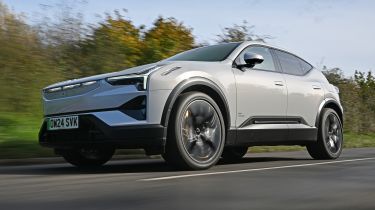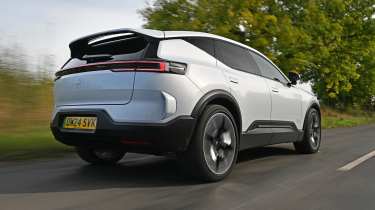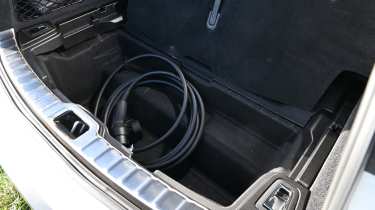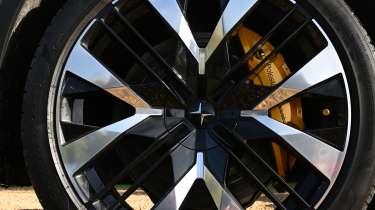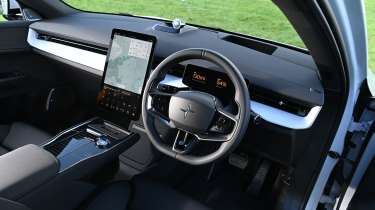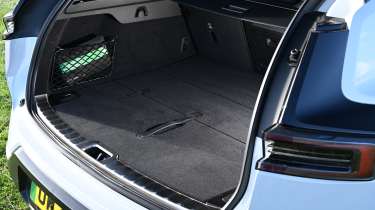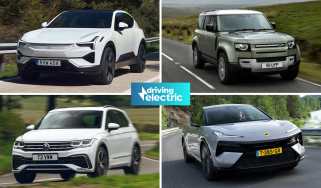Polestar 3 review
Good-looking, spacious, and plush, the Polestar 3 is an impressive big SUV. But it’s an expensive choice and the tech grates
Pros
- Impressive battery ranges
- Top-quality, spacious interior
- Good ride and handling
Cons
- Technology can be frustrating
- Efficiency could be better
- Expensive to buy
| Range | Wallbox charge time | Rapid charge time |
| 352-438 miles | 17hrs (0-100%, 7.4kW) | 30mins (10-80%, 250kW) |
Polestar 3 verdict
The Polestar 3 marks the Swedish brand’s debut in the growing premium electric SUV market, and it certainly has enough technology and plush materials to appeal to the more discerning buyer. Official battery ranges that start from 352 miles give it an edge over a number of rivals, too. The 3 perhaps isn’t as entertaining behind the wheel as the Polestar brand would have you believe, but there’s a nice balance between an involving drive and a comfortable ride.
Details, specs and alternatives
The Polestar 3 is the third standalone model to come from this Swedish brand, hence its name, and sits above the Polestar 4 coupe-SUV, which was launched afterwards. Prior to the 3, the Polestar 2 was the company’s only mainstream market entry, because the limited-production Polestar 1 PHEV sold in very small numbers. Of course, Polestar did exist before the 1 was introduced, but it was a performance subsidiary of Volvo at the time.
The Polestar 3 is a full-size premium SUV, which puts it in the ring with established models including the BMW iX and Mercedes EQE SUV, as well as the Volvo EX90, which shares the same SPA2 architecture.
In order to keep this large SUV ahead of the competition, the Polestar 3 is powered by a substantial 107kWh battery pack, which boasts some impressive claimed ranges. In entry-level Long range Single motor form, the Polestar 3 can return up to 438 miles per charge on the official WLTP tests. If you’re prepared to sacrifice some range for a bit more power, you can opt for the dual-motor models, with the Long range Dual motor offering up to a claimed 392 miles on a full charge, and the Long range Dual motor with Performance Pack giving 352 miles.
In order to prevent the big battery from keeping you waiting around when you need to top it up, the Polestar 3’s 250kW peak rapid-charging speed allows it to be charged from 10 per cent to 80 per cent in 30 minutes.
It takes more than a big battery for a car to appeal to buyers in this area of the market, though, so Polestar has ensured that its SUV’s design is a distinctive one. Exterior highlights such as the two-piece LED headlights, front and rear aero wings and flush side windows have been inspired by various sources, including aircraft and the brand’s own Precept Concept car. The Polestar 3 is a bulky vehicle, but it’s clear that its design is heavily influenced by aerodynamics.
Step inside and things will look fairly familiar if you’ve ever seen the cabin of a Polestar 2. The overall theme is still minimalism, but the materials are of a higher quality and there’s a lot more space, too.
As to be expected, this premium SUV comes at a premium price. For a while the only version available was the £80,000 Launch Edition, which came packed with 21-inch wheels, a Bowers & Wilkins sound system with Dolby Atmos, headrest speakers, a head-up display, a heated steering wheel, heated seats, and even heated wiper blades. Since then, the range has widened and starts at just under £70,000 for the Long range Single motor edition. Lots of kit is included as standard, and Polestar offers optional extras neatly bundled together in packs – these start at £1,200 and rise to £6,000.
Range, battery size & charging
| Model | Range | Wallbox charge time | Rapid charge |
| Polestar 3 Long range Single motor | 438 miles | 17hrs (0-100%, 7.4kW) | 30mins (10-80%, 250kW) |
| Polestar 3 Long range Dual motor | 392 miles | 17hrs (0-100%, 7.4kW) | 30mins (10-80%, 250kW) |
| Polestar 3 Long range Dual motor with Performance Pack | 352 miles | 17hrs (0-100%, 7.4kW) | 30mins (10-80%, 250kW) |
There’s only one battery available in the Polestar 3, and that is a sizable 107kWh unit. This is good for an official WLTP combined range of 392 miles in the Long Range Dual motor variant, which is more than the BMW iX or even the closely related Volvo EX90 can muster. Opting for the optional Performance Pack will reduce this figure to 349 miles, but if you prioritise outright range then the entry-level single-motor car should appeal because it can travel up to 438 miles on a full charge, Polestar claims.
When testing the Polestar 3 Long range Dual motor with the Performance Pack fitted, we saw an average efficiency of 2.4 miles per kWh, and this equates to around 256 miles of real-world driving – that’s nearly 100 miles down on the claimed 349-mile range.
The battery will need plenty of juice when it’s time to plug in, so in order to keep charging times down, the Polestar 3 has a peak DC rapid-charging speed of 250kW. This allows a 10-80 per cent top-up to be completed in around half an hour. If you’re charging at home, you’ll need to be prepared for a long wait because it’ll take around 17 hours for a full charge from a 7.4kW home wallbox unit.
It’s also worth noting that the Polestar 3 sits on 400V architecture, and this pales a bit in comparison to the 800V set-ups found in some other high-end electric cars like the Porsche Taycan. This higher-rated architecture allows faster charging and better efficiency.
Running costs & insurance
The premium SUV market isn’t one that caters for bargain hunters, and the Polestar 3 is no exception to this rule. With prices starting at just under £70,000 and rising to £81,500 before options, the Polestar 3 isn’t a cheap car – but nor is that surprising, you could say.
All versions of the Polestar 3 sit in insurance group 50, which is the same as its two chief rivals, the BMW iX and Mercedes EQE SUV, while from April 2025 the Polestar 3 (like all EVs) will attract £195 VED (‘road tax’).
For company car drivers, the Polestar 3 will sit in the 3 per cent in Benefit-in-Kind bracket in 2025/26 and 4 per cent in 2026/27.
The Polestar 3 should help to save you a small fortune on running costs when compared with a similarly sized combustion-powered SUV. Fully charging it at home will cost you around £32 at a typical household rate of 30p per kWh. As always, public charging may cost considerably more.
Performance, motor & drive
| Model | 0-62mph | Top speed | Driven wheels | Power |
| Polestar 3 Long Range Dual motor | 5 seconds | 130mph | Four | 483bhp |
| Polestar 3 Long Range Dual motor with Performance Pack | 4.7 seconds | 130mph | Four | 510bhp |
Polestar prides itself on being a sporty brand, and it was originally Volvo’s performance division before evolving into a standalone car maker. In fact, take a look at the brand’s website and the official slogan for the Polestar 3 is “Yes it’s an SUV, and it drives like a sports car". This is a bold claim, but the Polestar 3 doesn’t quite deliver on that promise.
Our test car was fitted with the optional Performance Pack, making the most powerful Polestar 3 that you can currently buy. With this pack fitted, the dual-motor powertrain is boosted to deliver 510bhp and 910Nm of torque, which actually isn’t that much more than the standard car’s 483bhp and 840Nm. The result is a cut in the 0-62mph sprint time from 5.0 seconds to 4.7 seconds, although both of these times are admirable for an SUV that weighs over two-and-a-half tonnes. The 130mph top speed remains the same.
The Polestar 3 can certainly shift in a straight line, but there’s no forgetting its heft when you’re sitting behind the wheel. The air suspension is floaty rather than firm, and this causes the 3’s weight to become very pronounced at lower speeds. It’s not all bad news when driving on smaller roads, though, because the Polestar is easy to place on the road and even has a reasonably compact 11.8-metre turning circle.
If you forget the sporty intentions, the soft suspension actually pays dividends when it comes to ride comfort. At motorway speeds, the Polestar 3 remains composed even when fitted with larger alloy wheels, and there’s very little noise intrusion. The steering is nicely judged, too, and gives a more connected feel than a Mercedes EQE SUV and even a Polestar 4.
When it’s time to slow down, the standard-fit Brembo brakes offer plenty of stopping power, but there’s only a limited amount of adjustment with the regenerative braking system. One-pedal driving is available by engaging ‘High’ mode, while the ‘low’ mode reduces the regen to be more passive in operation. Alternatively, you can also turn the system off entirely.
Interior, dashboard & infotainment
Premium electric SUVs now account for some of the fanciest interiors on the market, and Polestar has addressed this by adorning the Polestar 3 with softer and higher-quality materials than you’ll find on the Polestar 2.
Rather than going all-out with the design, though, the cabin follows a similar minimalist theme to the one used by Tesla. It’s a smart look, but it does mean that there are very few physical buttons and switches.
Instead of the majority of the Polestar 3’s functions being operated via switchgear, they are controlled through a 14.5-inch touchscreen running Google-based software. The layout of this system looks straightforward enough at first glance, however we quickly became frustrated with having to trawl through multiple sub-menus in order to access basic functions. To help reduce the time it takes to reach more commonly used functions, there are a limited number of customisable shortcuts on the home screen.
In front of the driver is a smaller nine-inch screen, which acts as the instrument display, and this is very well laid out with a pleasingly high resolution. There are also some buttons fitted to the steering wheel, but these aren’t illuminated or marked in any way, so you’ll need a very good memory.
Boot space, seating & practicality
| Length | Width | Height | Boot space |
| 4,900mm | 2,120mm | 1,618mm | 484 litres |
The Polestar 3 is a big car, so it’s only right that it should offer plenty of space inside. This is indeed the case, because five passengers (even taller ones) have loads of room to stretch out, especially in the back seats. Despite the car’s sloping roofline and a panoramic roof, there’s still plenty of headroom in this Polestar SUV.
There’s also a reasonable amount of room for bags, with 484 litres of boot space in the Polestar 3 - increasing to 597 litres when measured to the ceiling. If you have to carry any large objects, folding the rear seats will increase the Polestar 3’s boot capacity to 1,411 litres. To prevent any unfortunate back injuries when lifting heavy objects into the car, the 3’s air suspension can be lowered by up to 50mm.
If you need to hook up a trailer or caravan, the Polestar 3 is rated to tow a maximum of 2,200kg. Pressing a button in the boot will deploy the electric towbar – a £1,200 option – from the rear bumper.
Reliability & safety rating
It’s still a very new brand, but Polestar’s reputation for reliability is already a bit tarnished. According to our most recent Driver Power satisfaction survey, an alarming 69 per cent of Polestar 2 owners experienced a fault within the first year of owning their car. Hopefully the brand has taken this into consideration when building the Polestar 3, but only time will tell.
One area where Polestar is off to a strong start, though, is safety. Clearly channelling its inner Volvo, the Polestar 2 managed to score a full five-star Euro NCAP rating, and we’d expect the Polestar 3 to follow suit.
To help boost its score, the Polestar 3 is fitted with a suite of standard safety tech. The list includes 12 ultrasonic sensors, nine cameras, collision avoidance, adaptive cruise control, collision warning, road-sign recognition and rear cross-traffic alert.
On top of all the standard safety kit, the optional Pilot Pack also brings in pilot assist, lane-change assist and 360-degree cameras with 3D view.
